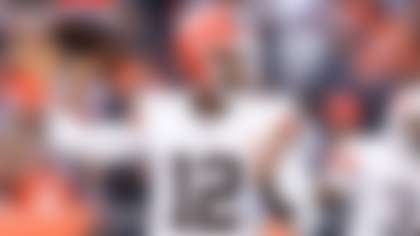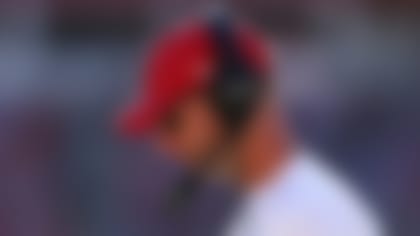ORLANDO -- And then there were two -- the best two.
The New England Patriots and Philadelphia Eagles are set to square off in Super Bowl LII for the right to hoist the Lombardi Trophy. Both enter with identical 13-3 records, tops in their respective conferences. Sunday will mark the fourth Super Bowl in the last five seasons to feature two No. 1 seeds.
Each squad boasts stellar playmakers on both sides of the ball. Super Bowl LII is the third in NFL history (first in nearly 40 years) between two teams both ranked top 5 in scoring offense and scoring defense (Eagles: No. 3 offense, No. 4 defense; Patriots: No. 2 offense, No. 5 defense).
The Patriots' and Eagles' journeys to the Super Bowl took much different paths. The upstart Eagles overcame a brutal injury to MVP candidate Carson Wentz, while the Patriots enjoyed Tom Brady's latest MVP-caliber season.
The question entering Super Bowl week is how the Eagles and Patriots stack up against one another. In that spirit, I spent time during Pro Bowl practices trying to find out from the game's best players what it's like to face New England and Philadelphia.
Facing the Eagles
The "underdog" Eagles were left as an afterthought when Carson Wentz went down in Week 14 with a torn ACL. Surely, even after clinching the No. 1 seed in the NFC, Nick Foles would be their undoing at some point.
Not in the NFC Championship Game, where the QB dive-bombed a great Vikings defense for 352 yards, three touchdowns and a 78.8 completion percentage.
Vikings safety Harrison Smith still sounded befuddled by the 38-7 blowout.
"We didn't make plays and they made pretty much all of them. I didn't think that would happen," Smith said.
In two playoff games, Foles is averaging a 77.8 completion percentage, thrown for 598 yards, has taken just two sacks, and earned a 122.1 passer rating.
The reason for Foles' success has been mostly attributed to a three-word offensive scheme: Run-Pass Option.
The RPO, which Smith referred to as a "trendy" offense, allows the quarterback the option to hand the ball off to the running backs or, if he reads the linebackers stepping up, pull the ball and zip it to a receiver. Doug Pederson's use of RPOs has gotten Foles in rhythm and proved deadly for defenders. This season, including playoffs, Foles has completed 93.8 percent of his RPOs, per Pro Football Focus.
As Carolina Panthers linebacker Thomas Davis told me this week, RPOs put defenders in a no-win situation when executed properly.
"It's pretty much a play where you can't be right as a linebacker," Davis said after Pro Bowl practice. "Because if you guess and you play downhill to play the run they're going to throw the ball right where you were. If you drop back and you play the pass, then they're going to hand the ball off. So the quarterback is basically reading the linebackers and safeties in that situation and it's a situation where a lot of the time you can't be right."
The key for the Eagles RPOs has been the steady play of running backs Jay Ajayi and LeGarrette Blount. If the threat to run isn't real, it takes the bite out of any RPO action.
"Those guys are tough runners," Smith said of the Eagles backs. "Both of them run extremely hard but they both have their own different style, so between Jay and LeGarrette they can do some damage."
Couple the RPOs keeping defenders off balance with a dominating offensive line and you have the recipe for a successful offense, no matter who is under center. The Eagles' underrated O-line deserves credit for moving bodies in the run game and keeping pressure off Foles.
"They have a very fast offensive line," Vikings defensive tackle Linval Joseph said. "... And they're very athletic, very strong at the attack. The center they have is a really good center. And 65 [Lane Johnson], they're fast athletes, they run 4.8-4.7. So as you see, they can get around the edge and change their plays up. Act like it's a screen and really it's a run."
Heading into the Super Bowl, that unpredictably will be key for Philly. The Eagles' spread-out system, coupled with a power-back duo, could take advantage of the Patriots' defensive weakness. We've seen similar offenses like the Kansas City Chiefs dice up Bill Belichick's squad in the past. When it comes to defending RPOs, the Patriots allowed 5.6 yards per play in 2017, fifth-most in the NFL, per PFF.
VikingsPro Bowl receiver Adam Thielen warned against underestimating the Eagles' secondary.
"They're a secondary that doesn't allow easy catches," Thielen said. "That whole week on film you saw how there were contested catches. Every single catch was contested. They were all over people. I don't think they get enough credit in the back end of how well those guys are playing ... guys are all over the place and in the right spots."
That opportunistic secondary plays off the quick pressure provided by the front four and Schwartz's blitz schemes.
"I think they know that that front four is really good and they're going to get pressure," Thielen said of the Eagles' secondary. "So they know they can be more aggressive and they can sit on routes and they can do things like that. They know how to play with each other. They're very well coached. And their technique is some of the best out there."
The coaching angle shouldn't be oversold. While Bill Belichick is one of the greatest coaches in the history of sports, the work Pederson, Schwartz and the rest of the Eagles staff has done is worthy of this Super Bowl run. Despite all the injuries, the coaches found strengths of players who took over and accentuated those attributes.
Sunday we'll see if the "underdog" Eagles have the formula to pull off one more "upset" this postseason.
Facing the Patriots
Facing the Patriots means tackling Tom Brady. The G.O.A.T. The five-time Super Bowl champion. The player who makes 40 look like 29. The greatest quarterback of all quarterbacks. A man so hydrated in greatness he pees pure excellence from morning until night.
"I'm telling you it is electrifying," Jaguars linebacker Telvin Smith said of preparing to face Brady. "Just through the whole week, knowing you're going to go against one of the guys who is going to be considered one of the best to play the game ever. It's your task to go out there and stop him, being a defensive guy, so it's tough but I'm telling you it's an experience through the week like no other."
The Jaguars slowed Brady early in the AFC Championship Game, but, like so many teams before, eventually succumbed to the man with more playoff comebacks (8) than any QB in NFL history. Smith said the plan for attacking Brady is simple:
"Hit him. He's old. Let's not beat around the bush about it," he said. "Hit him, get him down, put him on the ground, let him feel us, let him know that we're there."
The book on Brady is well-read (and executed best in the past by the New York Giants): Get pressure with only four, move Brady off his spot, and cover on the back end.
Easier penned than accomplished.
As the Jags found out, the Patriots' offensive line can snuff out pass rushes as games wear on. And Brady is a master of finding matchups in his favor. In this iteration of the Patriots offense, Brady utilizes Rob Gronkowski and the running back trio of Dion Lewis-James White-Rex Burkhead to create mismatches all over the field.
The Pats use these mismatches to get speed on slower linebackers. While Gronk uses his big body to create separation, running backs like Lewis and White can eat up defenders in space.
"In football, space is your worst enemy," Smith said. "The more space a guy has from you or coming towards you can put you in a bad position. So you just got to eliminate the space from those guys. And they're quick, they don't want big bruiser backs, they want quick scat backs, so you've got to be a different breed, like myself."
Panthers linebacker Thomas Davis pointed out that it's not just the mismatches that Brady and the Patriots scheme, but how those running backs are able to understand the proper option route the quarterback is reading.
"They do a good job of reading your leverage as a linebacker and optioning off that," Davis said of New England running backs.
Dolphins safety Reshad Jones said bumping Patriots receivers -- Brandin Cooks, Chris Hogan, Danny Amendola -- is key to throwing off Brady's timing.
"You've got to slow the receivers down. You've got to slow the timing down of the quarterback and receivers," Jones said. "So I think the best thing from a defensive back standpoint is to make sure your DBs get up, put your hands on the receivers so Tom Brady can't just pitch and catch. It's not just easy throws for him."
The Dolphins owned the physical corners and four-man pass rush to execute such a game plan, but Jones said he doesn't think personnel is as important as the commitment to sticking with a physical style.
"A lot of guys play off when they play those receivers," he said. "I don't think it's personnel. Anybody can get the job done. You just got to get up and get your hands on them to slow the timing of the receiver and the quarterback to throw the timing off."
Many teams have tried to knock Brady off his game. Some can do it for a quarter. Some a half. Few have succeeded for four full quarters.
Brady's heroics often overshadow a Patriots defense that is better than the sum of its parts. Defensive coordinator Matt Patricia heads a D that might allow a boatload of yards, but stiffens in the red zone and makes key stops in crucial situations.
"They mix it up," Dolphins receiver Jarvis Landry said of facing the Pats' D. "They've got a great defensive coordinator. Those guys are well-coached over there. The difference I think about those guys, they're a bend-but-don't-break defense. Those corners on the outside compete at a high level. [Malcolm] Butler competes at a high level. [Stephon] Gilmore competes at a high level. [Eric] Rowe has stepped in. And those two safeties back there, they're two of the smartest that are playing the game right now, [Patrick] Chung and [Devin McCourty]. That's always good to have in your defense."
The Patriots ranked 29th in yards given up per game, but fifth in points per game allowed and fourth in red-zone defense.
Los Angeles Chargers offensive lineman Russell Okung said what makes the Patriots' defense difficult to face -- especially in the red zone -- is that they constantly break tendencies.
"Interesting about them is they game-plan really well," Okung said. "You may see something from them that you didn't expect. You can't really respect their tendencies. Let's say you're in the red zone, and most teams blitz in the red zone and get the ball out of your hand. And they'll sort of play back. So it's sort of things you're expecting them to do, and they'll flip the script on you."
Flipping the script has allowed Belichick and Patricia to keep offenses off balance despite not owning high-profile talent. What has given New England the most difficulty in recent seasons is a spread attack that puts pressure with quick tosses. Couple that with a power run game, and you might have a formula to beat New England.
"For us, we were lucky to have multiple playmakers that we could spread them out and do a lot of different things which allowed us to have success," Landry said of the Dolphins' 27-20 victory over the Pats in Week 14.
Even if you can beat Belichick's defense, there's always that Brady character who can overcome seemingly any deficit.
"Facing Tom, you know that you can never show your hand," Davis said. "He's a guy that totally understands the game of football, he understands defense, and if you give him a look that's obvious, then he's going to take advantage of it. So you've got to do a good job of mixing those looks up."
Mixing up looks long enough to keep Brady befuddled is a plan easier said than executed for 60 minutes.












